It’s the time of year when the temperature drastically begins to dip, all the while leaves of various colors are falling off trees in all directions.
The fall season is unique in its aesthetics, but it should also present a visual reminder of what is yet to come in terms of detrimental outdoor weather events. The winter season brings with it a slew of challenges.
That is because the season’s cold temperatures hits the plant life on your property in multiple ways. Some serious negative effects on plants and trees, including broadleaf evergreens like azaleas, laurels and rhododendrons, include leaf damage that can make colorful leaves brown – or could even kill them entirely, leaving trees barren and causing more upkeep the next year.
Drying out is also a concern due to dehydration. Frozen ground limits water delivery to plant roots, leaving plants capable of using stored water in stems or leaves to resort to that option. Some plants, like evergreen shrubs and trees that don’t get rid of leaves, are in difficult situations.
Trees and shrubs can be susceptible to this during cold winter months, due to water not being able to be properly “delivered” to plants and roots. That’s usually a result of the ground being too cold, or frozen. Hence, plants have to use whatever water is stored in their stems and leaves — a dangerous scenario for plants like evergreen shrubs and trees that don’t ditch their leaves during the season.
Winter burn and winter leaf scorch are also not uncommon. Winter burn occurs when a tree releases water during the process of transpiration, eventually dehydrating due to moisture not being replenished. Winter leaf scorch, often identified as purple or brown discoloration on evergreens’ needle ends, happens during dry winter winds that combine with frozen earth.
So, how do you combat all these possible pernicious effects of winter? Call the experts at Camelot Tree and Shrub today to employ anti-desiccant spray, which reduces water loss by applying a thin waxy barrier over the plant’s stomata to hold moisture in.
We high suggest this winterization treatment during the fall season, syncing the application with temperature decreases below 50 degrees. It prepares trees and shrubs for dormancy.
Call Camelot today to benefit from this treatment and preserve your trees and plants. Taking care of your living environment is a 12-month task.





